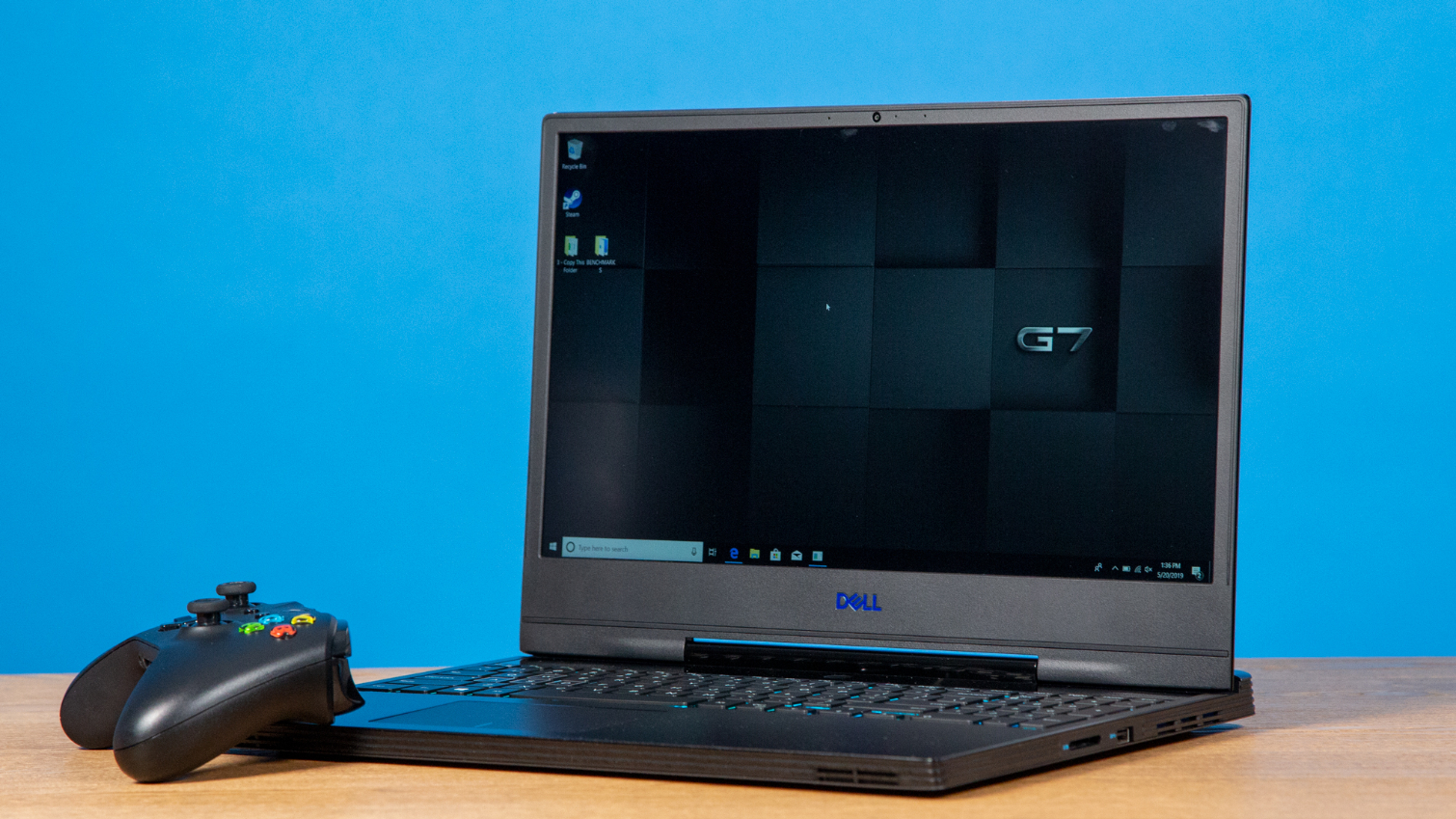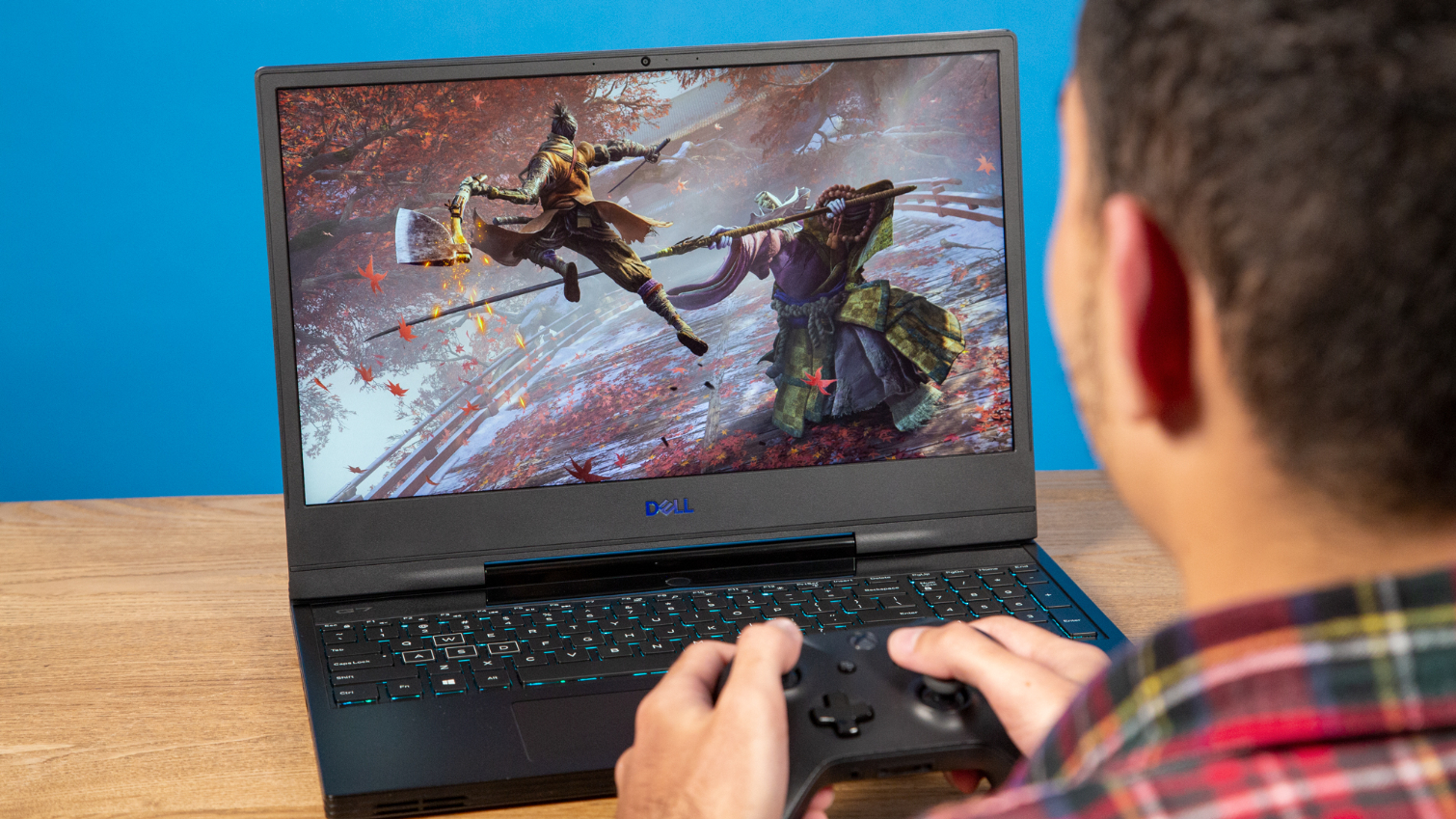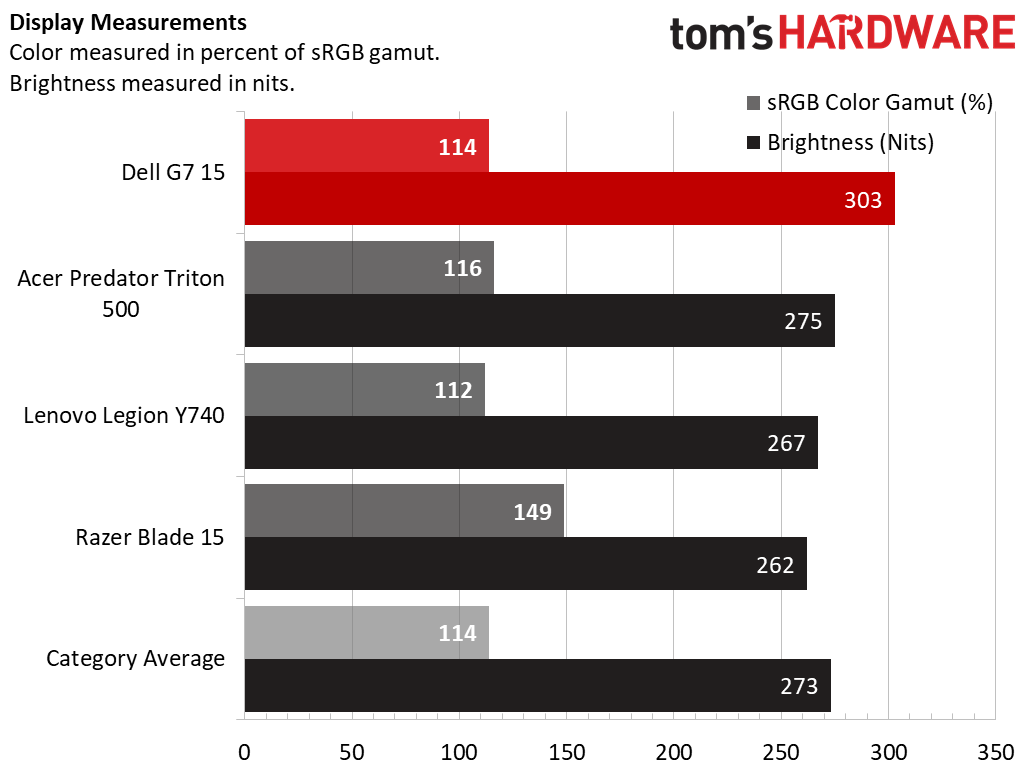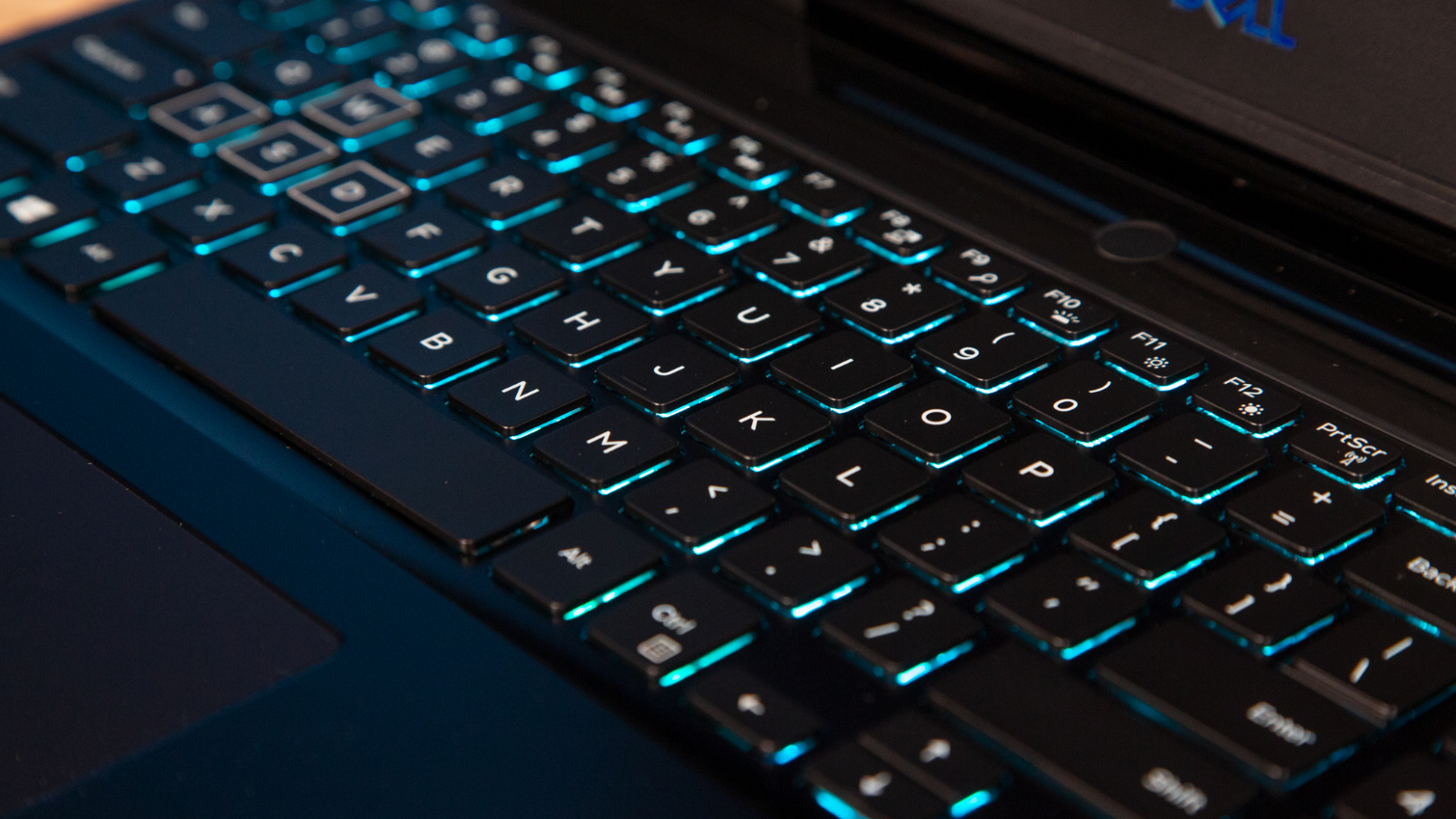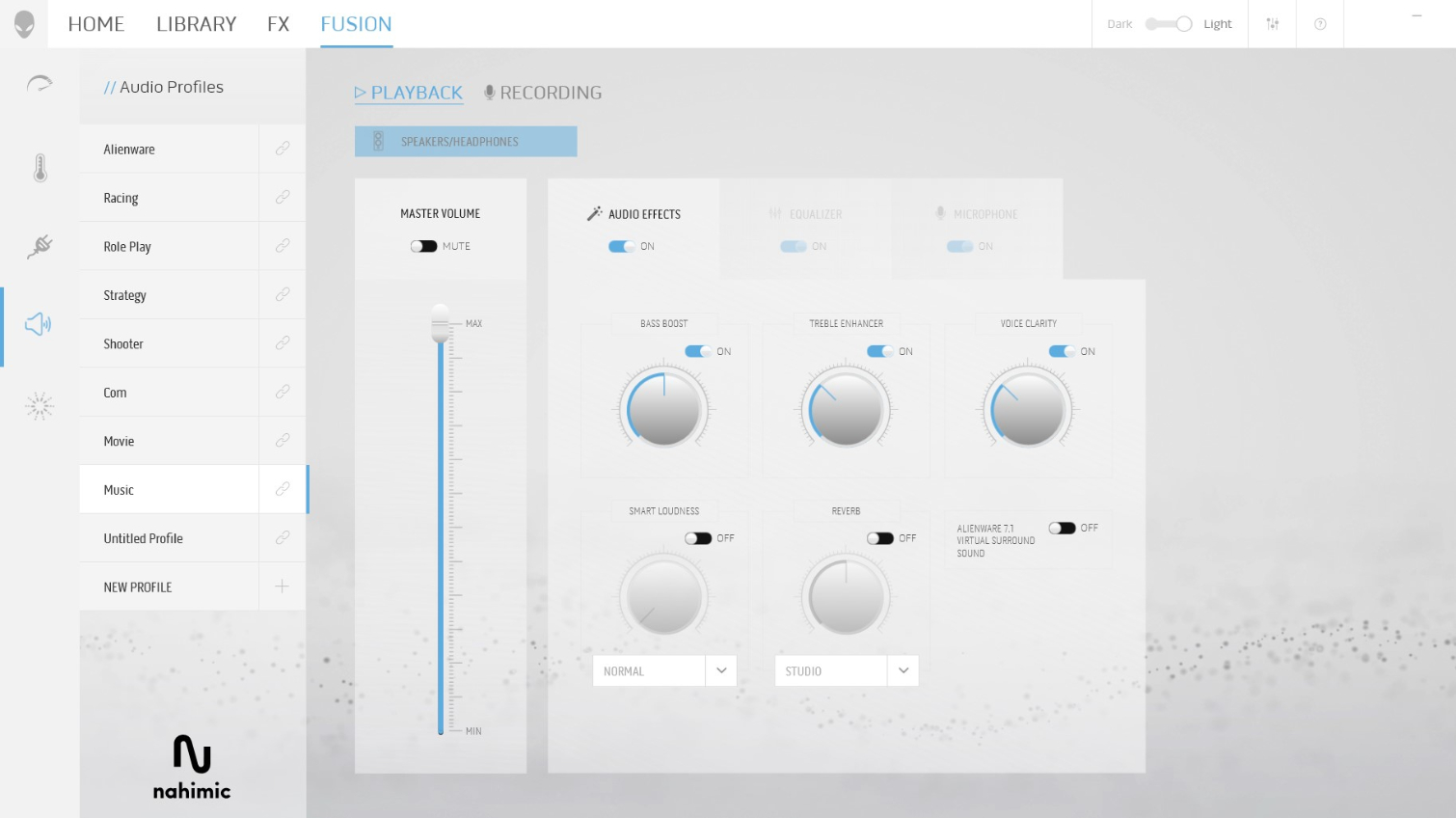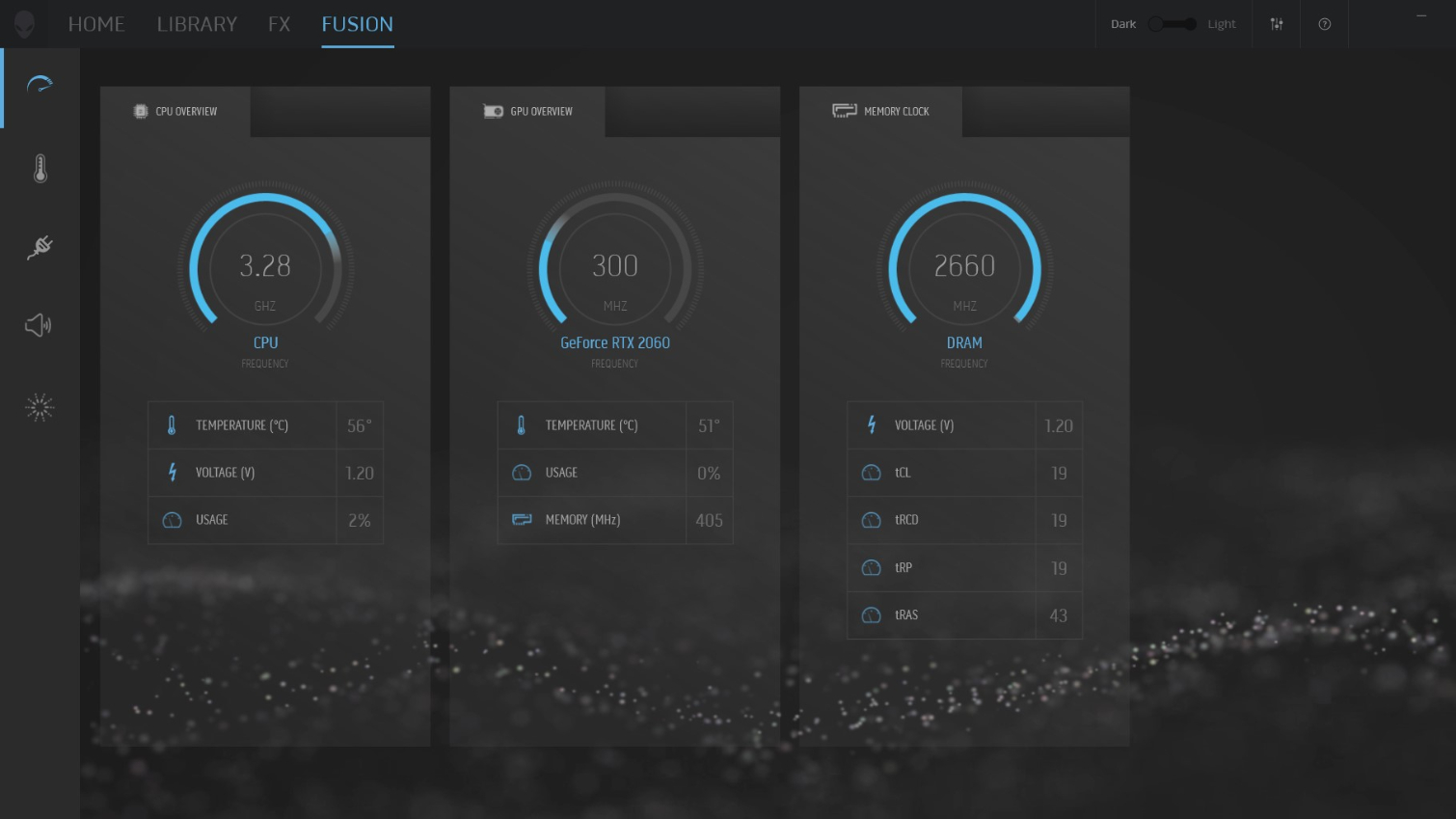Tom's Hardware Verdict
The Dell G7 15 has a subtle design that’s upgrade-friendly with decent all-around performance. But competitors offer more-colorful screens, and sound quality could use a boost.
Pros
- +
Good webcam
- +
Mature design
- +
Upgrading instructions labeled on some components
- +
Bright 144 Hz-refresh screen
- +
Above-average gaming and productivity performance for this price range
Cons
- -
Dim RGB keyboard
- -
Below-average battery life
- -
Tinny audio
- -
Screen could be more colorful
Why you can trust Tom's Hardware
With a 9th Gen Intel CPU, RTX 2060 graphics card and high refresh rate screen, the Dell G7 15 ($949 to start, $1,399.99 as tested) offers a lot, including better gaming and productivity than what’s average for this price range. But there are more impressive options, including with more colorful displays, if you’re willing to spend a little more.
Dell G7 15 Specs
| Display | 15.6-inches, FHD (1920 x 1080) IPS, 144 Hz |
| CPU | Intel Core i7-9750H |
| Graphics | Nvidia GeForce RTX 2060 (6GB) |
| Memory | 16GB (2x 8GB DDR4-2666) |
| SSD | 256GB M.2 PCIe-NVMe |
| Hard Drive | 1TB, 5,400-RPM 2.5-inch SATA |
| Networking | Killer Wireless 1550 2x2 AC, Bluetooth 5.0, RJ-45 Ethernet |
| Ports | 3x USB 3.1 Gen 1 Type-A, Thunderbolt 3, HDMI 2.0, 2-in-1 SD / Micro SD card reader, Headphone/mic jack, RJ-45 Ethernet, Noble lock slot |
| Audio | 2x speakers |
| Camera | 720p resolution |
| Battery | 60 WHr |
| Power Adapter | 180W |
| Operating System | Windows 10 Home |
| Dimensions (WxDxH) | 14.4 x 10.8 x 0.8 inches (365.8 x 274.3 x 20.3mm) |
| Weight | 5.5 pounds (2.5kg) |
| Price (as configured) | $1,399.99 (config not available in the UK) |
Design
Dell went safe with the G7 15’s design, with relative sleekness as a bigger priority than flashy colors or attention-seeking accents.
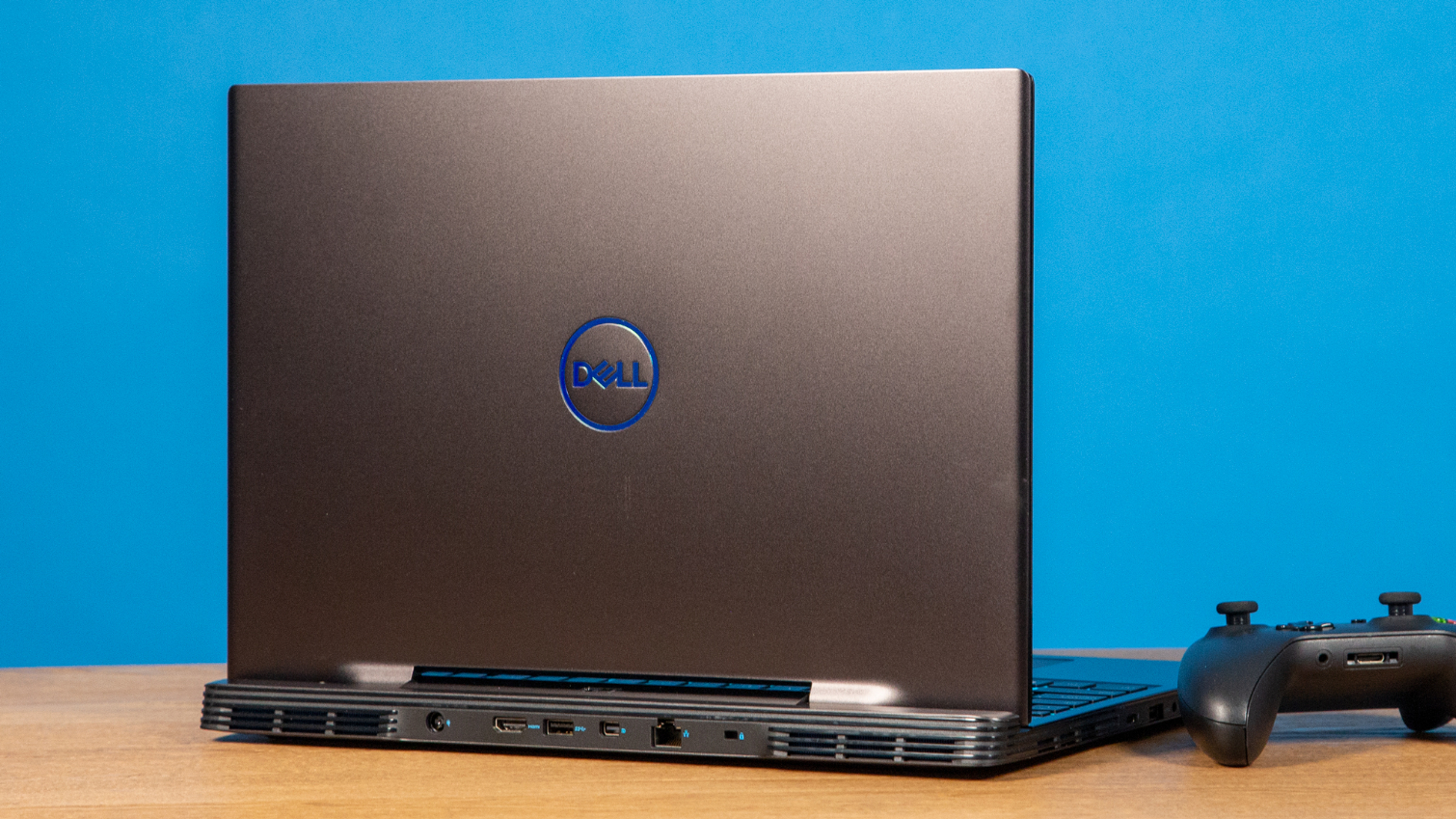
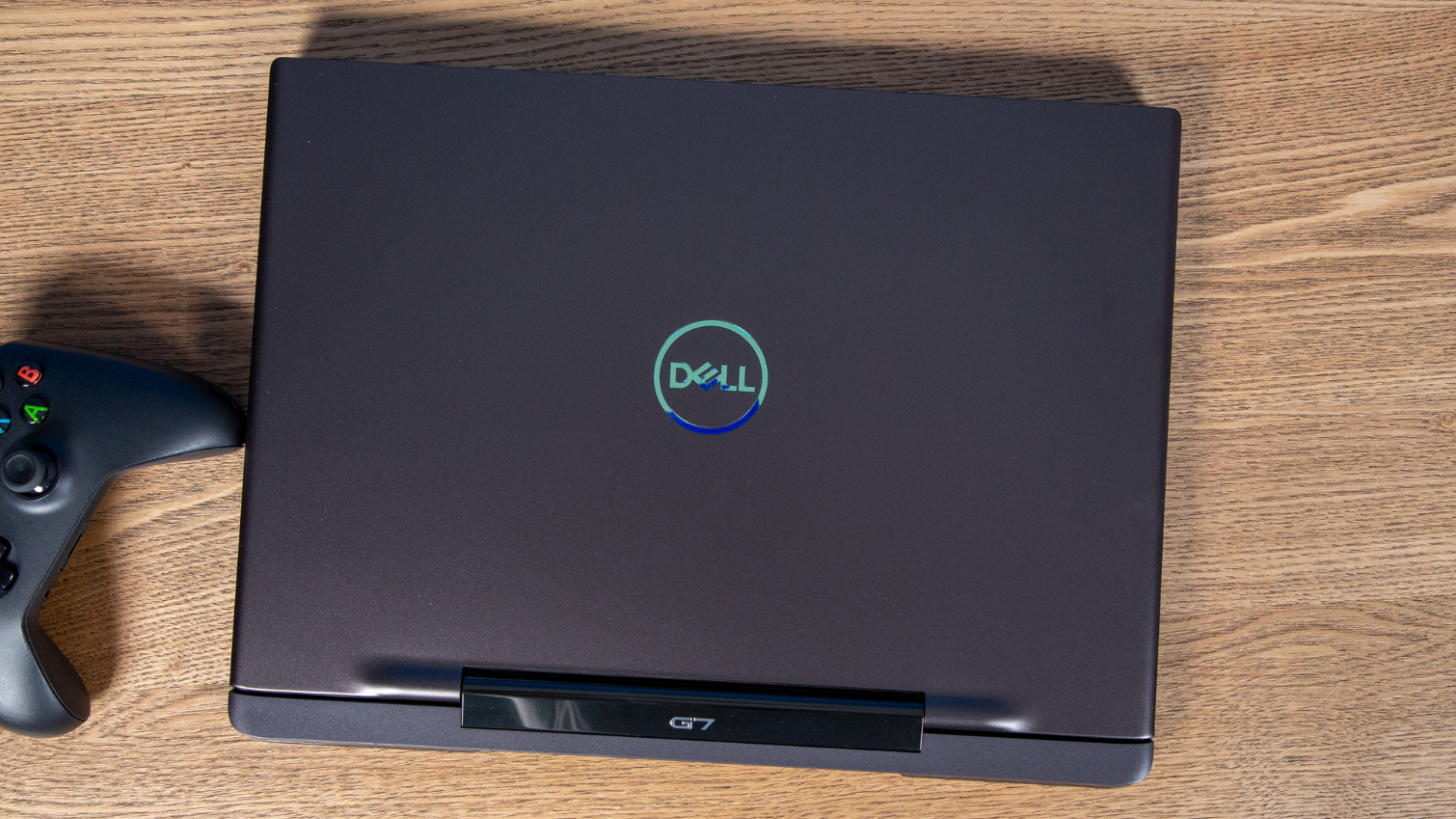
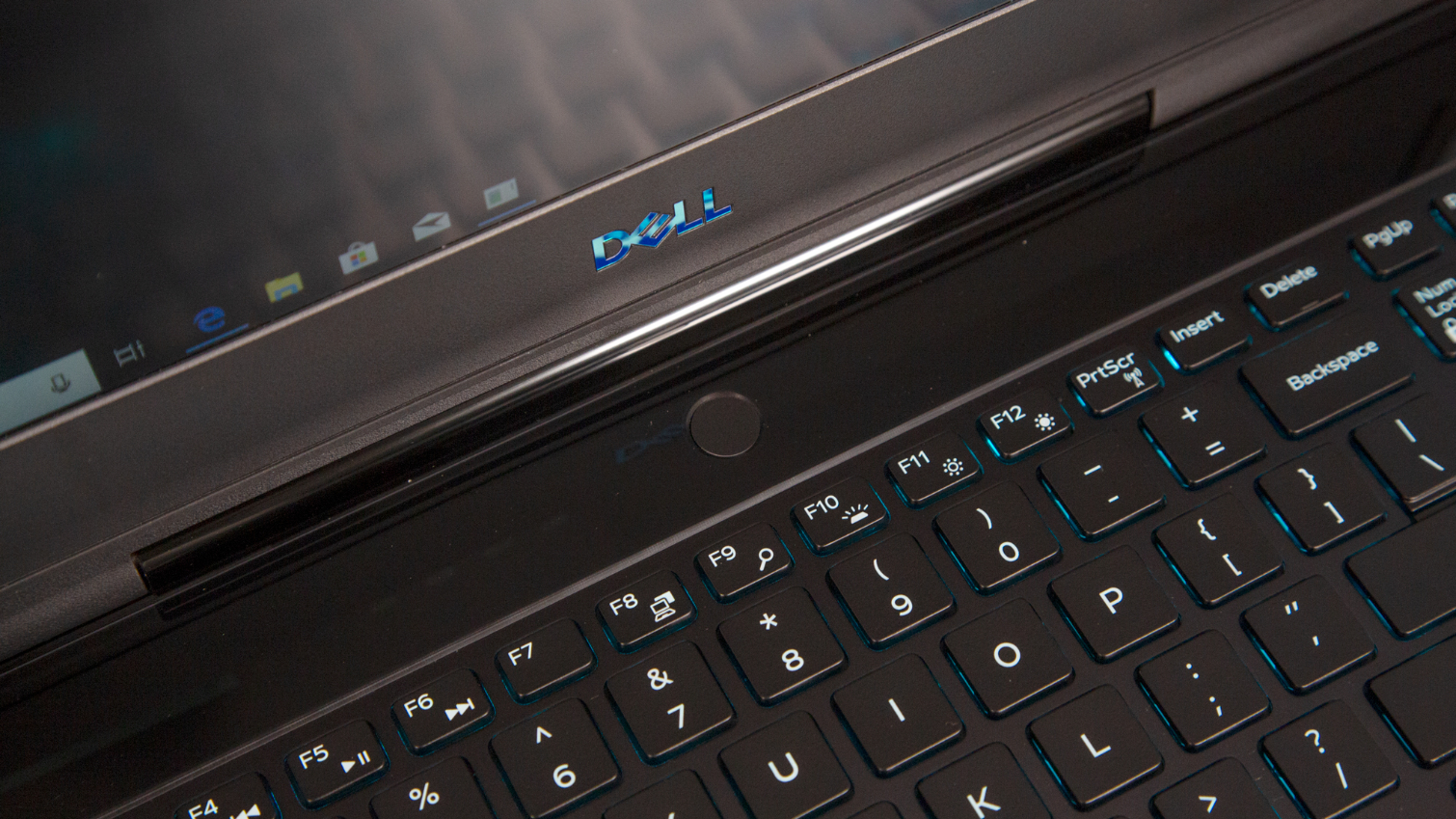
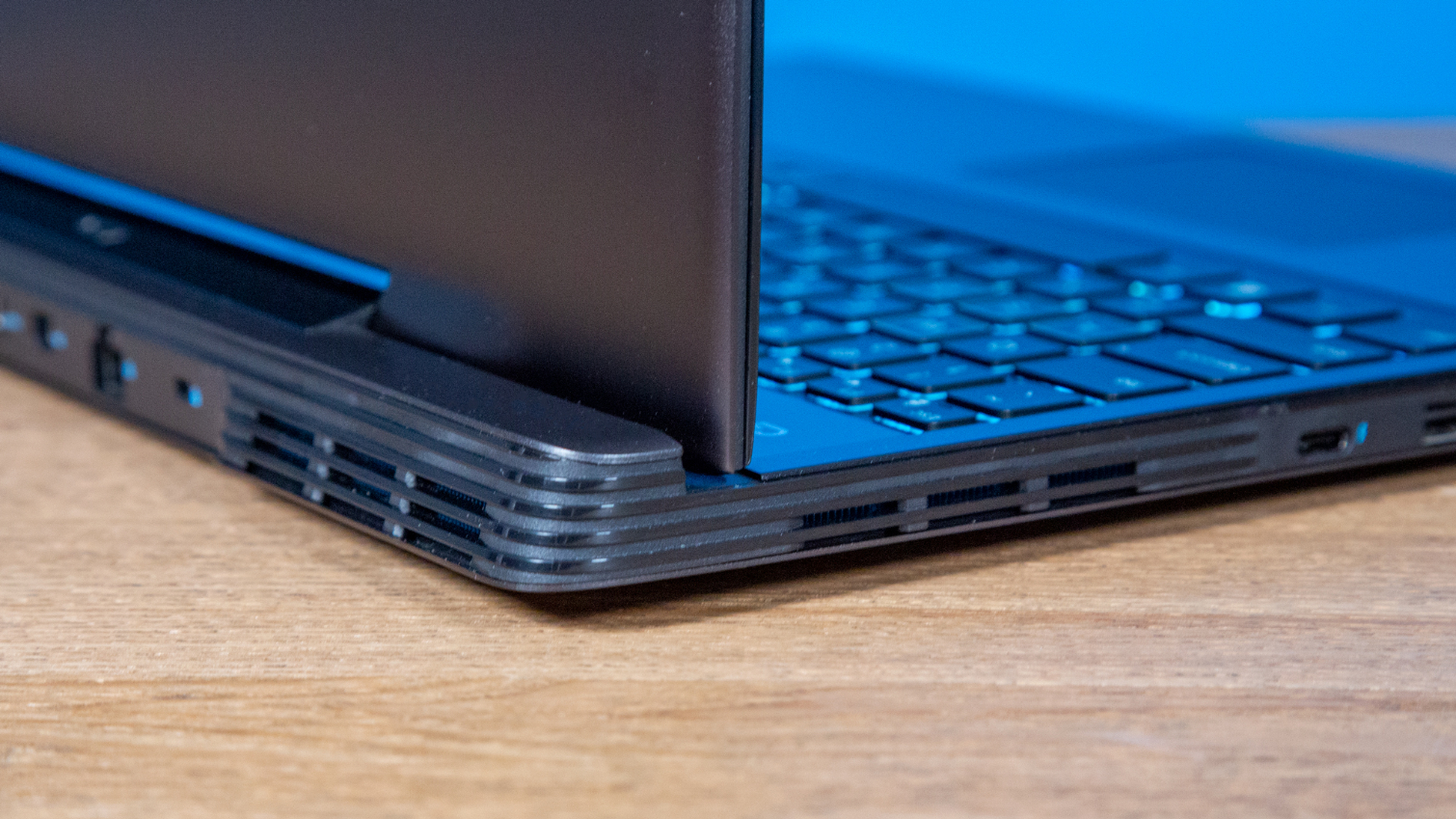
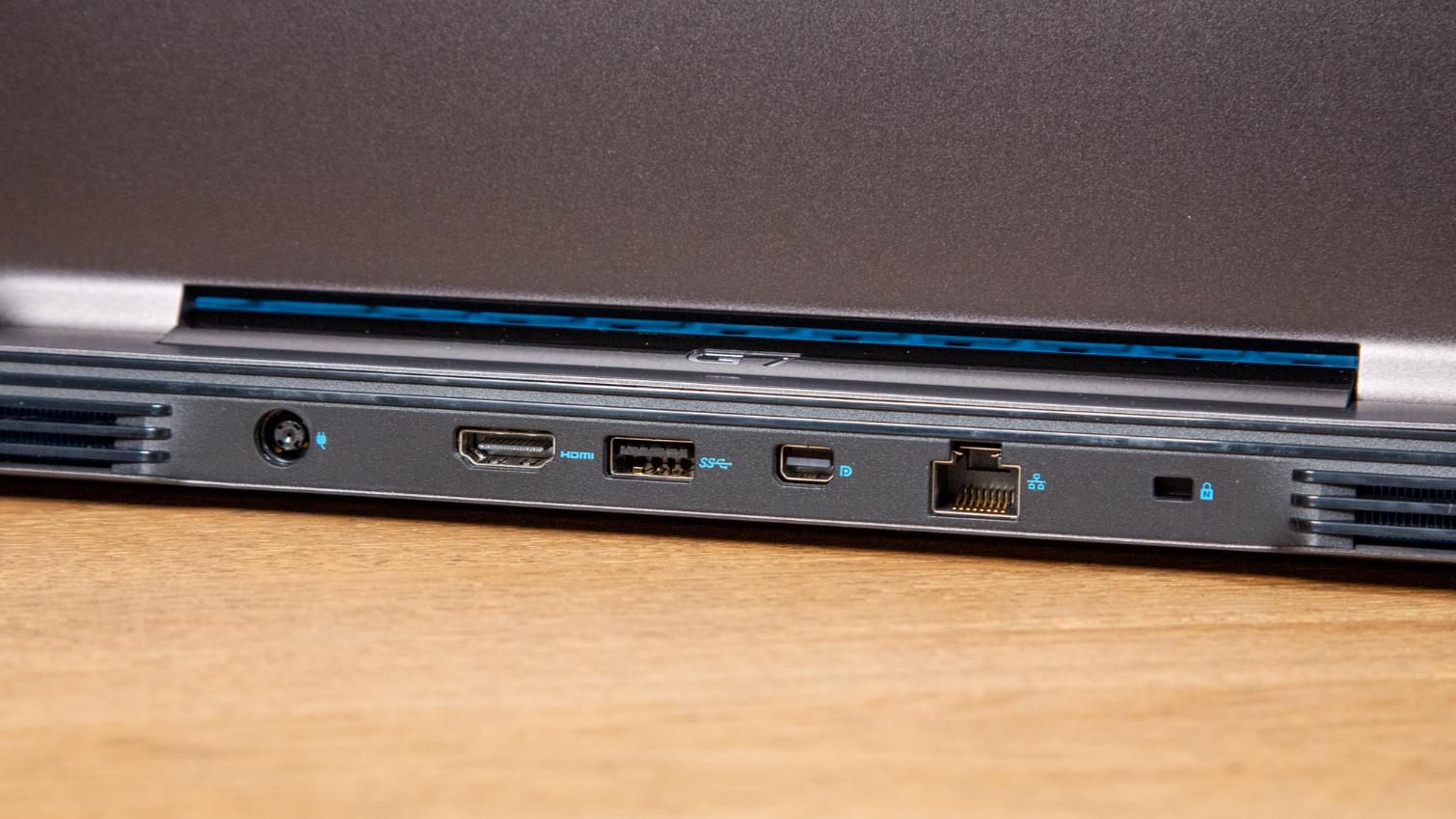
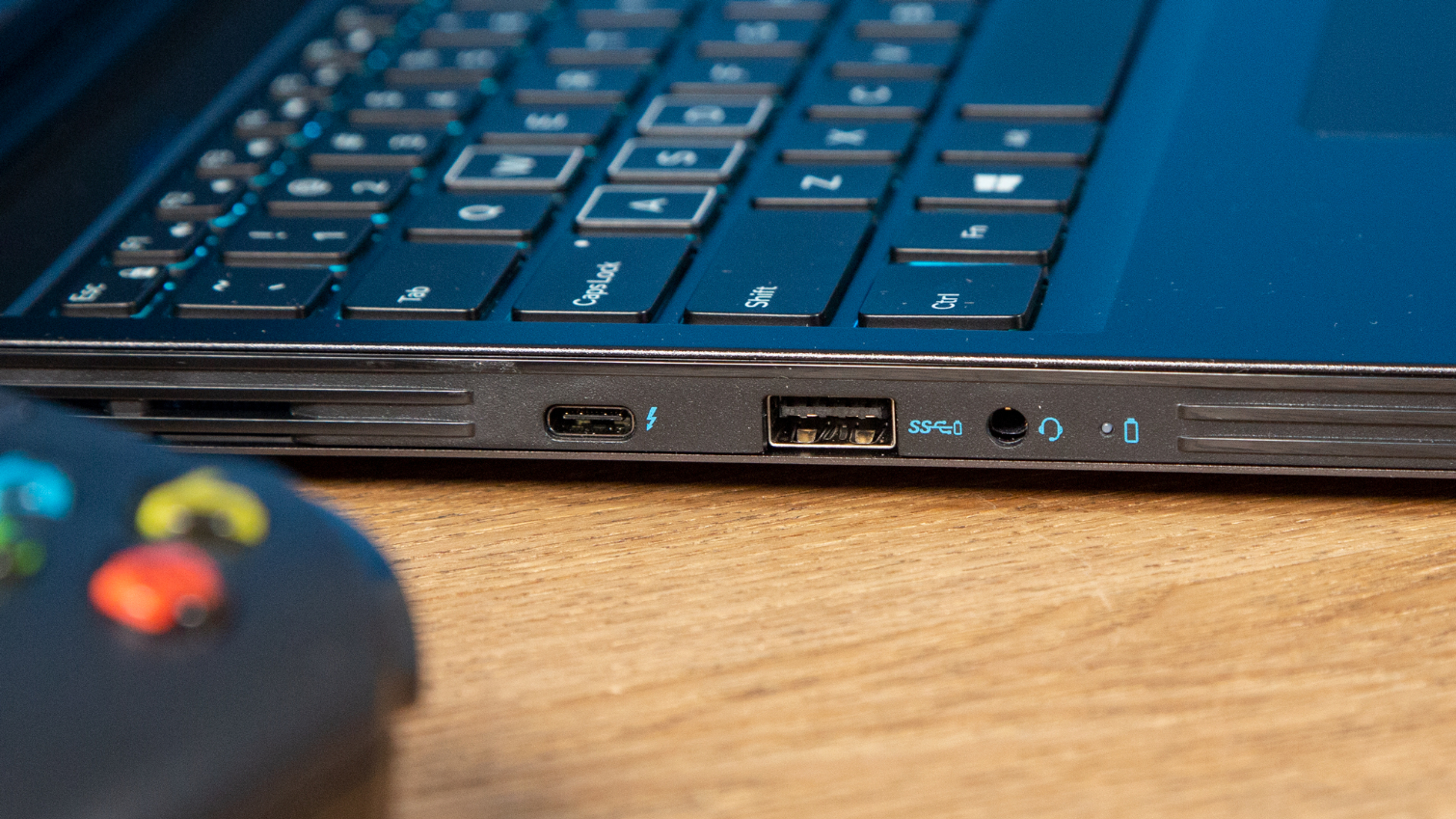


The lid features my favorite part, a reflective, prismatic Dell logo that’s bright blue in some lights and sea green in others. Besides that, the only lid accents will be your fingerprints, which are present but subtle since the “abyss grey” coloring is just a step away from black.
The hinge has a “G7” logo that shows off the model of your Dell machine. At least the font has an edgy look to it.
The Dell logo on the bezel below the 15.6-inch screen is reflective like the one on the plastic lid, reminding us that less can be more when it comes to color. The deck, also plastic, isn’t slippery, making for a good place to rest your wrists while typing. The top part of the deck is smoother and more reflective with the power button sitting centered below the screen, nearly incognito with its lack of labeling.
It’s hard to miss the vents that line the sides, and on the sides and back you can even see a bit of blue between those slats if you look closely. I always appreciate seeing more color, but because of the subtlety these splashes of blue are harder to appreciate.
That same blue is used for the port labeling, bringing more of an impact color-wise than the vents. The ports on the left side are a Thunderbolt 3, USB 3.1 Gen 1 and a headphone/mic jack. On the right side is a 2-in-1 SD card reader and another USB 3.1 Gen 1. Turn the G7 15 around to access the power adapter, an HDMI port, another USB 3.1 Gen 1, Mini DisplayPort, Ethernet and a noble lock slot. All USB 3.1 Gen 1 ports can charge a device even if the PC is off.
Get Tom's Hardware's best news and in-depth reviews, straight to your inbox.
I was surprised by how heavy the G7 15 is (5.5 pounds) considering its sleek build. It measures 14.4 x 10.8 x 0.8 inches. This is comparable to similar gaming laptops, like the Acer Predator Triton 500 (14.1 x 10 x 0.7 inches, 4.7 pounds), Lenovo Legion Y740 (14.2 x 10.5 x 0.9 inches, 5 pounds) and Razer Blade 15 (14 x 9.3 x 0.7 inches, 4.7 pounds), but heavier than them all.
Gaming, Graphics and VR
The G5 15’s Nvidia GeForce RTX 2060 (6GB) graphics card, paired with an Intel Core i7-9750H CPU, makes for decent gaming performance even at high settings.



When I played Battlefield V, one of today’s most demanding titles, with ray tracing at low and all other graphics settings at high, the game usually ran between 60 and 69 frames per second (fps) but went as high 80 fps and as low as 50 fps as I guided Deme Cisse through 1944 Provence.
With Grand Theft Auto V set to very high settings at 1080p resolution, the G7 15 averaged a strong 66 frames per second (fps), surpassing the mainstream gaming laptop average and tying with the Triton 500, which has the same graphics card but a previous-generation i7-8750H CPU. It fell just 1 fps short of matching the Legion Y740 though (RTX 2070 Max-Q and i7-8750H), but 10 fps behind the Blade 15 (2070 Max-Q / Intel UHD Graphics 630 and i7-8750H).
On the Shadow of the Tomb Raider benchmark at 1080p resolution with the highest settings, the G7 15 averaged 49 fps, again surpassing the category average and tying with the Predator Triton 500. The G7 15 couldn’t top the average frame rate posted by the Legion Y740 though.
During the Middle-earth: Shadow of War benchmark with ultra settings at 1080p, the G7 15 output a strong 77 fps, tying yet again with the Triton 500 with its matching GPU. However, the Legion Y740 and Blade 15 averaged 10 and 14 more fps, respectively.
When we ran the Hitman benchmark at 1080p with ultra settings and DirectX 12, the G7 15 hit an impressive 88 fps, again above the category average, and edging just past the Triton.
And feel free to plug in your best VR headset. The G7 15 earned the highest score possible on the SteamVR test, an 11.
To stress test the G7 15, I ran Metro Exodus 15 times on a loop at the highest settings with the RTX preset, which includes ray tracing, to simulate about 30 minutes of gaming. It started off at a modest 45 fps in the first run and maintained a 44.3 fps average, dropping to the 43 range for just one run. During the benchmark, the CPU ran at an average clock speed of 3.99 GHz and average temperature of 64.7 degrees Celsius (148.5 degrees Fahrenheit). The GPU was on average 49.3 degrees Celsius (120.7 degrees Fahrenheit).
Productivity Performance
Our configuration of the G7 used an Intel Core i7-9750H, a six-core, 12-thread CPU with a clock speed of 2.6 GHz and turbo of 4.5 GHz. That’s paired with 16GB of memory, a sufficient amount of RAM for most gamers and for storage, a 256GB M.2 PCIe-NVMe SSD and 1TB SATA hard drive.
Those specs made easy work of running 26 Google Chrome tabs, including one streaming The Office from Netflix (while I still can), and Slack software. Even when swapping through tabs rapidly there was no lagging or delays, and I could hear the cringe-inducing antics of “Date Mike” playing without stuttering.
In our productivity benchmarks, the Dell gaming laptop usually showed above-average performance compared to the typical gaming laptop in this price range, but often that wasn’t enough to best competitors.
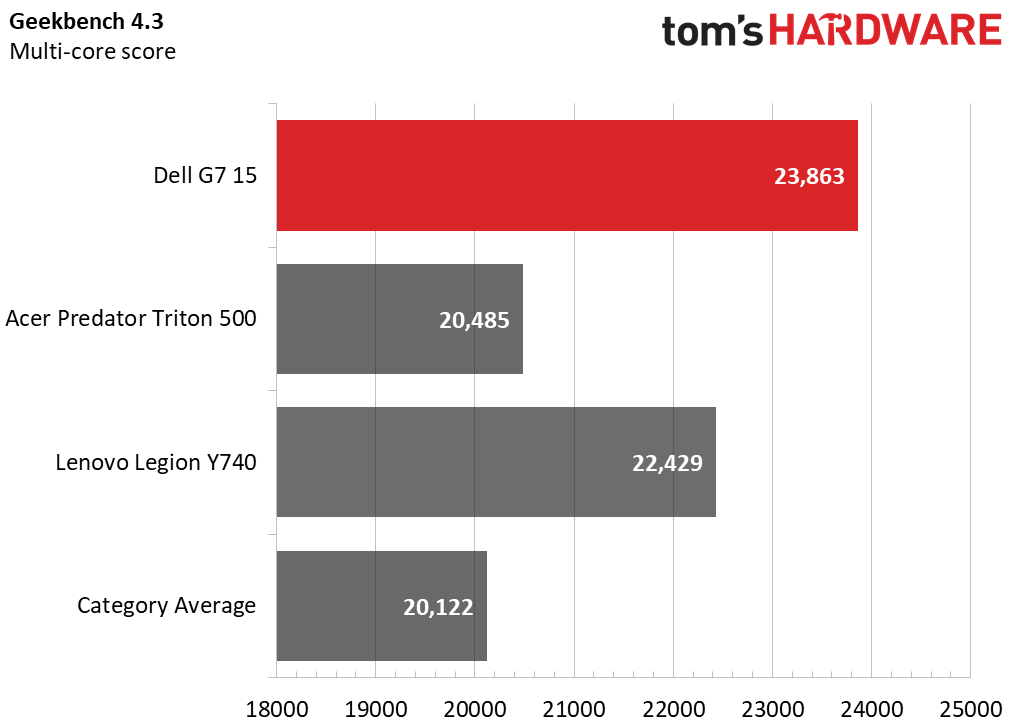
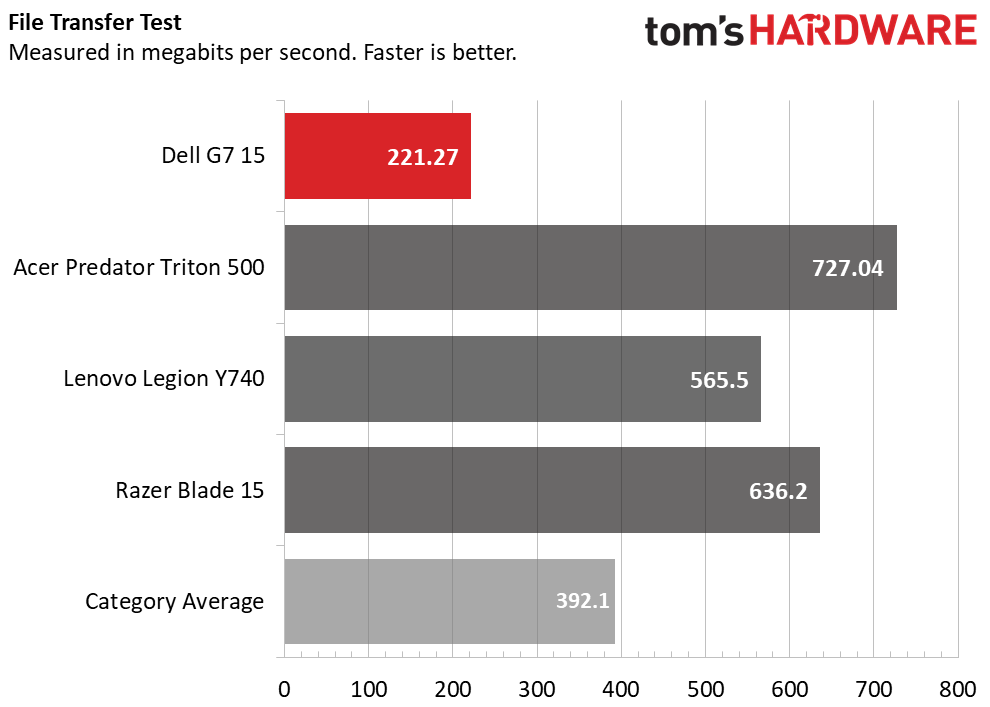

On Geekbench 4.3, a benchmark that measures overall performance, the G7 15 scored a 23,863, surpassing the 20,199 category average and our comparison sample.
In our file transfer test, it took the G7 15’s SSD 23 seconds to copy 4.97GB of mixed media files, a rate of 221.3 MBps. That’s slower than the typical gaming laptop and much slower than the Triton 500, Legion Y740 and Blade 15.
When tasked with transcoding a 4K video into 1080p resolution in the Handbrake benchmark, the G7 15 took 8 minutes and 5 seconds. This is 2:25 faster than the average laptop and an impressive 4:48 quicker than the Blade 15. However, the Triton 500 and Legion Y740 got the job done 1:18 and 1:53 quicker, respectively.
Display
With a 144 Hz refresh rate, you can expect the G7 15’s screen to display smooth frames without lag, even during fast-paced gaming. And with that speedy screen being an IPS panel, I was also hoping for strong color and great views, even when looking at the display from a side angle.
When I watched a trailer for Terminator: Dark Fate I was disappointed in how scant Arnold Schwarzenegger’s appearance was, as well as difficulties in seeing details in darker scenes. Colors like gold goo underneath a terminator’s skin and a plains landscape were colorful, but I struggled to see what was going on in a dark hotel room or nighttime fight scene. However, the IPS delivered, in terms of offering a visible view when watching from a perpendicular angle.
Throughout a sunny level in Provence in Battlefield V, colors like the orange of foliage, explosions and fire reflections in a puddle, red blood droplets on my gun’s barrel and green moss were strong.
Our testing showed the G7 15 covers 114% of the sRGB color gamut, matching the category average and a touch more colorful than the Legion Y740’s screen. However, the Triton 500 has a slightly more colorful display, and the Blade 15 is significantly more colorful. But what it lacks in colors the G7 15 makes up with 303 nits of brightness, outshining all of our comparison PCs.
Keyboard and Touchpad
The G7 15 sports a four-zone RGB keyboard with a numpad but no macro keys. You can control the RGB lighting via the included Alienware Command Center software. It includes 7 themes, but one is them is a boring Static Blue. For cycling themes, like Rainbow Wave or Spectrum, you can pick between a low, medium or high speed.
You can also adjust the brightness of the lighting, but I always left mine maxed out. Under certain lighting, the keys look a little dim, with the colors glowing through the white white font but not from out under the shallow keys.
The keys are noticeably shallow at 1.38mm but not unforgivably so, with their clickiness helping the situation. The keys require 76g of force to actuate, although some more spring would be even better, especially for long typing sessions. I hit 109 words per minute on the 10fastfingers.com typing test with a 97% accuracy rate. This is speedy, but less accurate than normal for me.
The 4.1 x 2.5-inch unified touchpad has a matte feel that’s smooth but not slick. With Windows precision drivers three and four-finger gestures worked reliably on the first try.
Audio
Peeking from behind the deck’s slats are two speakers that look small, but at max volume produced noise big enough to fill my living room / kitchen. When playing Battlefield V the gunshots were a booming disturbance, making me anxious for the firing to cease. At this volume, ABBA’s “Dancing Queen” was loud enough to fill my living room/kitchen combo, and I could even get my fix from my neighboring bedroom without feeling the need to make it louder.
But while the sound was powerful, it wasn’t full. In Battlefield V, gunshots sounded a little hollow, even with Alienware Command Center software’s “shooting” audio profile enabled. And ABBA’s usually melodic voices sounded tinny and high.
Alienware Command Center uses Nahimic technology for tuning. It has different sound profiles, including one for Music, and each profile has tweakers for bass, treble, vice clarity, smart loudness, reverb and a surround sound toggle. There’s also an audio recon section for controlling the direction of the sound.
When I switched from the Default mode to Music, “Dancing Queen” became less tinny but only by a subtle amount. Activating the treble enhancer brought a notable improvement, but the ’70s hit still wasn’t as rich as when played on my Bluetooth speaker.
Gamers can also use the Alienware Command Center to control the sound, using the audio recon menu.
Upgradeability
The G7 15 is not just upgrade-friendly, it’s near upgrade-encouraging with the RAM and hard drive labeled with upgrading instructions.
To get inside the G7 15 I had to unscrew 9 Phillips head screws, but only 7 of them actually come out (the other two only loosen). I easily pried the back cover off and was greeted with a pleasing amount of blue, thanks to the dark blue PCB and the blue-dyed heatpipes that peek through the vents on the laptop’s spine.
You can also upgrade the Wi-Fi module by unscrewing one Philips screw. My M.2 SSD was covered by a metal shroud, removable with 2 Phillips screws. Once that’s off you can get to the final Phillips screw to replace the SSD (you can adjust the screw for the more common 2280 M.2 SSD form factor). I also appreciated how secure the power connector (up top, left-center) is, with a metal bracket holding it in.
Battery Life
The 60WHr battery powering the G5 15 is short-lived, even for a gaming laptop. We put it through our battery test, which continuously browses the web, streams videos and runs OpenGL benchmarks over Wi-Fi with the screen at 125 nits brightness. The Dell laptop lasted just 3 hours and 12 minutes, 52 minutes shorter than the average gaming laptops in this price range. On the other hand, the Legion Y740 will have you reaching for a charger almost an hour sooner than that.
Heat
During heavy gameplay, the G7 15 gets noticeably warm. After about 20 minutes, I started feeling the heat on the keyboard.
Using a Flir camera, we checked the surface temperatures of the PC after streaming 15 minutes of HD video from YouTube. The spot between the G and H keys was 38.1 degrees Celsius (100.5 degrees Fahrenheit), the touchpad was 30.3 degrees Celsius (86.5 degrees Fahrenheit) and the bottom was 37.5 degrees Celsius (99.5 degrees Fahrenheit).
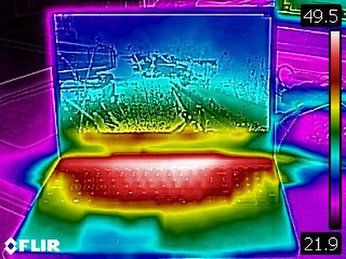

After gaming for 15 minutes, we checked temperatures again. The keyboard hit 49.5 degrees Celsius (121.1 degrees Fahrenheit), and the hottest point, the bottom, was 51.2 degrees Celsius (124.2 degrees Fahrenheit).
Webcam
The image quality of the 0.9MP, 720p resolution shooter sitting atop the G7 15’s display is a pleasant surprise. When using it facing a sunny window in a softly lit room, images lacked the visual noise that plagues many webcams. And my skin tone was color accurate, a rarity, as was my hair (minus a few highlights).
On the other hand, when using the webcam with a sunny window behind me, the background was washed out, and the image got blurrier. But it’s clear you can get good image quality with the right lighting.
Software and Warranty
Dell preloads its G7 15 with numerous software you might ignore, like My Dell, Dell Customer Connect, Digital Delivery, Mobile Connect, Power Manager and Update and SmartByte Diagnostics.
There’s also the standard Windows 10 bloatware, like Candy Crush Friends and Candy Crush Saga, a shortcut to LinkedIn, Skype, a Dropbox promotion, Netflix, Xbox Game Bar and Xbox Console Companion.
Additionally, there’s Thunderbolt Control Center and Killer Control Center for managing network usage. But what stands out most is Dell's Alienware Command Center software.
The Alienware Command Center is easy on the eyes with an optional dark mode. More importantly, it offers a place to view info on CPU, GPU and RAM usage, customize keyboard RGB lighting, sleep settings and tweak sound profiles and audio recon settings.
Configurations
Our configuration of the G7 15 is $1,599.99 (at the time of writing) and sports an i7-9750H CPU, RTX 2060 (6GB) graphics card, 16GB of RAM, plus a 256GB M.2 SSD and 1TB hard drive and a speedy 144 Hz refresh rate display. You can opt for a 240 Hz display for an extra $50.
The most expensive configuration of the G5 15 can be customized with a 60 Hz, anti-glare OLED, anti-glare screen for $2,599.99. It has the same CPU and RAM as our review unit but upgrades to an Nvidia GeForce RTX 2080 (8GB) graphics card and uses a 512GB SSD for storage.
The lowest price option starts at $999.99 and kicks off the savings with an Intel Core i5-9300H / Nvidia GeForce GTX 1650 (4GB). This config cuts the amount of RAM in half to 8GB, and has a 128GB SSD and 1TB hard drive. It also uses a 60 Hz screen and drops the keyboard’s RGB lighting in favor of blue backlighting.
Bottom Line
The Dell G7 15 packs a lot of power, including an RTX 2060 and 9th Gen Intel CPU in a pretty sleek but simple-looking package for a gaming laptop. At $1,399.99, our configuration was superior in gaming and productivity benchmarks when compared against other gaming laptops with similar price tags. It often tied with the pricier Acer Predator Triton 500.
But if you’re looking for something more premium, our configs of the Lenovo Legion Y740 and Razer Blade 15 often outperformed it in both categories. Plus, the Blade 15 has a more colorful screen than the G7 15, which sometimes lacked in darker scenes. However, the Legion Y740 ($1,919.99) and Blade 15 ($2,649) used for comparison were more expensive than the Dell at the time of review.
Shortlist the G7 15 if you’re looking for a gaming machine that gets the job done at a decent price, while also being slim enough to slide in a bag with relative ease.
Photo Credits: Tom's Hardware
MORE: Best Gaming Laptops
MORE: Laptop Reviews
MORE: All Laptop Content

Scharon Harding has over a decade of experience reporting on technology with a special affinity for gaming peripherals (especially monitors), laptops, and virtual reality. Previously, she covered business technology, including hardware, software, cyber security, cloud, and other IT happenings, at Channelnomics, with bylines at CRN UK.
-
Vitsasa Please can someone help me. I just got the Dell G7 7500 (2020) laptop. I have the Alienware command center. I wanted to make the light have the rainbow wave effect, I got into the FX part, but I am failing miserably to make it look like the videos where the rainbow travels down the light strip. Can anyone help me make it do that. I am brand new to this kind of system and can use all the help people can give.Reply -
thepersonwithaface45 Reply
You should start a thread for this, more people will see your issue.Vitsasa said:Please can someone help me. I just got the Dell G7 7500 (2020) laptop. I have the Alienware command center. I wanted to make the light have the rainbow wave effect, I got into the FX part, but I am failing miserably to make it look like the videos where the rainbow travels down the light strip. Can anyone help me make it do that. I am brand new to this kind of system and can use all the help people can give.
